#module 3
Explore tagged Tumblr posts
Text
Shooting The Truth: Can Art be Mechanically Reproduced?
By: Jayden Henderson, Hazel Angela Abiog, Ralph Danrique Aquino

Solace Road- Photo by Jayden Henderson
The quiet still of a teen beside a parked car on a country road carries a strong sense of place—its "aura," in Benjamin's terms. You can almost feel the late‑afternoon sun, hear the gravel underfoot, smell the dry grass in the breeze. That aura is captured in its original print in this single moment. Yet once digitized and shared online—cropped, filtered, re‑posted on Instagram or TikTok—it becomes one image among millions. Its unique presence is diluted, but its personal story spreads to a broader audience. Here, Benjamin's paradox is apparent: mechanical (now digital) reproduction diminishes aura, but simultaneously bestows new social life on the photograph, inviting strangers everywhere to participate in that teen's quiet pause.
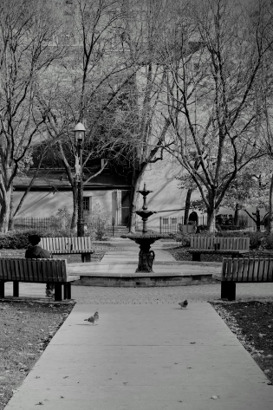
Lone Plaza- Photo by Jayden Henderson
An empty plaza, its benches and fountain surrounded by bare branches, feels like a relic of public life paused in time. In its original print, framed carefully, this stillness is tethered to that spot and those specific trees. However, once published in a book or blog, it becomes a hinge between private contemplation and mass experience. Benjamin would celebrate this shift: as art's reproducibility expands, the work slips out of exclusive gallery spaces into communal memory. Any passer‑by online can "visit" the plaza, forging new social bonds through shared images of absence and anticipation.

In Transit- Photo by Jayden Henderson
The photograph vividly captures the stillness of time, showing commuters, the train interior, and platform signs through a glass pane. It powerfully demonstrates how light can fracture and reassemble reality. The past and present, inside and outside, seamlessly blur into a striking montage. Benjamin would undoubtedly recognize this image as proof that reproduction does more than copy; it transforms our understanding of reality. By integrating multiple frames, exposures and spatial perspectives into a single frame, the image compels us to rethink perception itself. While its aura may be fragmented, it reveals a new social goal: capturing the intricate complexity of our urban experience.

The Cities Flow- Photo by Jayden Henderson (Entry by Hazel Angela Abiog)
This photograph connects to Walter Benjamin's article by illustrating how art and photography have become modern. Benjamin argued that mechanical reproduction removes the "aura," making them more accessible but less unique. City life, tall buildings, and walking people are not rare but repeatable. But that's the point: turning everyday life into something worth capturing and sharing with the world.

Grace in Silence- Photo by Hazel Angela Abiog
This picture reflects Robinson's style through several key elements. First, the use of Pictorial Quality is evident in the use of black and white, to show the aesthetic of early photographic images. Second is the Mood and Expression. The figure, downward gaze, and flowy dress suggest a quiet, thoughtful, or even a sad feeling that is similar to the images that Robinson often showed in his work. Third, Stage Composition stands out with the curved staircase, and the person placement creates a dramatic visual, like Robinson's carefully arranged images. Overall, this image shares the intentionality and emotional tonality of Robinson's photography.

Out of the Dark- Photo by Ralph Danrique Aquino
Robinson's craft of photography aimed to create a work of art, a painting, that highlights the storytelling and emotions, detailing reality. In this image, it creates a dramatic scene composing: a single figure surrounded by natural, emphasizing the dry and melancholic environment. The dark, moody atmosphere creates a sense of symbolism, much like Robinson's romantic and depressing themes. Moreover, the railroad tracks suggest a personal and emotional journey, conveying loss and grief in relation to Robinson's "Fading Away".
Module 3 Questions:
1. When something is reproduced countless times, is it still "art"? What is the importance of mechanical reproducibility, and how has it impacted society?
Reproducing an artwork over and over transforms it but doesn't render it meaningless. According to Walter Benjamin, every original piece possesses an "aura," born of its unique time, place, and history. Mechanical reproduction inevitably diminishes that aura, yet it also increases access. No longer confined to museum walls or private collections, art spreads into classrooms, living rooms, and public squares. This mass circulation shifts art from an elite privilege into a shared cultural resource, enriching public discourse and allowing diverse communities to engage with works they'd never encountered.
2. What is the central message of Walter Benjamin's essay "The Work of Art in the Age of Mechanical Reproduction"?
Benjamin's core Message is that mechanical reproduction disrupts the bond between an artwork and its "aura". By stripping away the "here and now" of the original, reproduction dissolves its aura, but in doing so, it empowers art to serve new social functions. Benjamin invites us to see reproduction not simply as loss, but also as transformation.
3. Is photography an art form in its own right, or merely a tool for traditional artists?
Photography began as a technical process for capturing reality but has long since become a standalone art form. When photographers bring a distinct vision—through composition, lighting, framing, etc.- to their work, they move beyond mere documentation. A photograph can tell stories, convey moods, and provoke reflection as powerfully as a painting or sculpture.
4. How and why did Henry Peach Robinson create Fading Away?
Robinson pioneered combination printing to stage the emotionally charged scene, Fading Away. By merging several negatives—each depicting different figures and settings—he choreographed a Victorian tableau of a young woman's last moments surrounded by mourning family. His goal was not scientific accuracy but dramatic storytelling: to show that photography could evoke pathos and narrative depth, rivalling the grand history paintings of the era.
5. If mechanical reproduction revolutionized art in the 20th century, what does today's digitalization mean for its future?
We've entered a new era where anyone with a smartphone can create, edit, and instantly share images on platforms like Instagram and TikTok. Digital tools dissolve barriers even further, raising new questions of authenticity. Who is the artist when an AI generates an image from a prompt or combines existing works? As we embrace these innovations, it's worth asking: What are we gaining in creative possibility, and what might we be losing in human touch and historical context?
References
•Benjamin, W. (1936). The work of art in the age of mechanical reproduction. Marxists Internet Archive. Retrieved May 16, 2025, from https://www.marxists.org/reference/subject/philosophy/works/ge/benjamin.htm
•The Editors of Encyclopaedia Britannica. (n.d.). Henry Peach Robinson. In Encyclopaedia Britannica. Retrieved May 16, 2025, from https://www.britannica.com/biography/Henry-Peach-Robinson
•OpenAI. (2025). ChatGPT (o4‑mini) [Large language model]. https://openai.com/chatgpt
3 notes
·
View notes
Text
Dr. P Check-in Gameful World - Module 3 #writ671mu
These chapters and particularly Benson's bring up the role of positive/negative reward pathways in playing that I think is an interesting connection back to Stuart's Ethics as well as creating new links to biology (these terms are frequently used in neurobehavioral studies). With these player-centric theories that focus on play as biological--are we giving something up for this definition? I also notice the focus on the individual was key in the writing outcomes as well though all of these theories in one way or another acknowledge the social aspects of learning and play. I feel like in some ways we are gaining a more refined definition of play in these recent chapters but I'm trying to make it make sense with some of Huizinga's claims and even Stenros' own "spirit of play." I guess both can exist simultaneously (as is common in play characteristics) I just think it is interesting that there seems to be a return to the aspects of play (and writing) that are physical/biological. Is this a tension that is just central to play? We've encountered about 60+ years of theories and all of them seem to share some of this tension.

Sorry --turned into more of a rant than a question
3 notes
·
View notes
Note
hope you feel better soon!

I am riddled with ailments, but I stay silly!
#ask#non mdzs#My health journey has been: Hernia -> acid reflux -> Vocal pain due to aforementioned reflux -> chest infection.#I'm terrified to know what's about to hit me next. Please let it be something kind. PLEASE.#The consequence of living with linguists is that you'll wake up with a wacked up voice -#suddenly you're sitting you down in front of a program called something like Praat having your shimmer and jitter levels calibrated.#They gave me a GRBAS of 33012. I have a fun thing called a pitch break where a whole octave just does not exist.#My vocal pain was bad enough I ended up seeing a speech pathologist and that whole experience was super neat!#I learnt a lot about voice - to be honest I might make a little comic on it after some more research. Fascinating stuff.#For example; your mental perception of our voice modulates the muscles of the vocal folds and larynx.#meaning that when you do have changes (inflammation = more mass = lower frequency)#your brain automatically attempts to correct it to what it 'should sound like'. Leading to a lot more vocal strain and damage!#And it gets really interesting for trans voice care as well - because the mental perception of one's voice isn't based on an existing sampl#So a good chunk of trans voice training is also done with the idea of finding one's voice and retraining the brain to accept it. Neat!#Parkinsonial Voice also has this perception to musculature link! The perception is that they are talking at a loud/normal volume#but the actual voice is quite breathy and weak. So vocal training works on practicing putting more effort into the voice#and retraining the brain to accept the 'loud' voice as 'normal'.#Isn't the human body fascinating?#Anyhow; Now I have vocal exercises and strategies to reduce strain and promote healing.#Which is a lot better than my previous strategy of yelling AAAH in my car until my 'voice smoothed out'.#You can imagine the horror on the speech path's face. I am an informed creature now.#I'm my own little lab rat now. I love learning and researching. Welcome to my tag lab. Class is dismissed.#I'll be back later with a few more answered asks </3 despite everything I'm still going to work and I need the extra sleep.#Thank you for the well wishes! And if you read all of that info dump; thank you for that as well!
441 notes
·
View notes
Text
rip secunit 3 😔😔😔 you're not dead but you would have loved saving the lives of a whole colony of innocent humans by making a factually honest and emotionally compelling documentary 😔😔😔
#thinking about system collapse chapter 7 again. as one does#and so much of murderbots epiphany about media#is based on it finally unpacking and understanding exactly what 2.0 did and why it worked so well for three#mb watching sanctuary moon right after hacking its governor module -> mb enjoying kinda shlocky “good type of unrealistic” media#🤝#three viewing the helpme.file as it hacks its governor module -> threes appreciation for nonfiction media#im the pepe silvia meme rn#its all connected. what im saying is three is set up to become a documentary fanatic and i love that for it#i hope it gets to make a documentary someday.#the murderbot diaries#murderbot#secunit 3#system collapse
475 notes
·
View notes
Text



Apollo 9 Gumdrop (CSM-104) prior docking with the Lunar Module Spider (LM-3).
Date: March 7, 1969
NASA ID: AS09-24-3631, AS09-24-3624, AS09-24-3652
#Apollo 9#Apollo CSM Block II#CSM-104#Gumdrop#Lunar Module#LM-3#Spider#NASA#Apollo Program#D-type mission#space#orbit#March#1969#my post
97 notes
·
View notes
Text
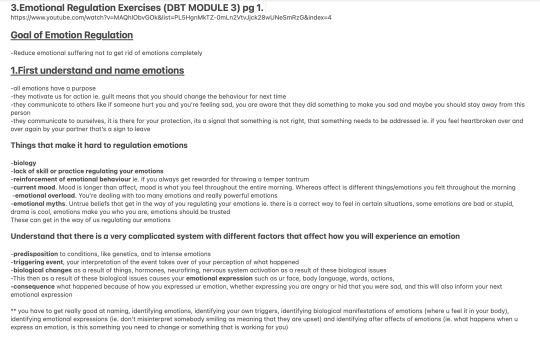
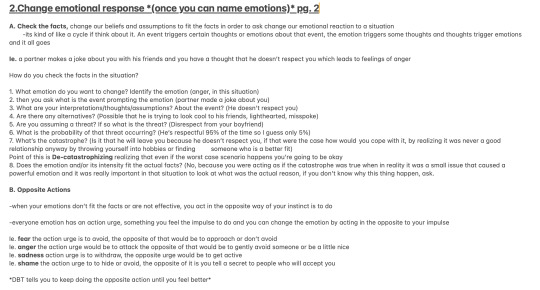
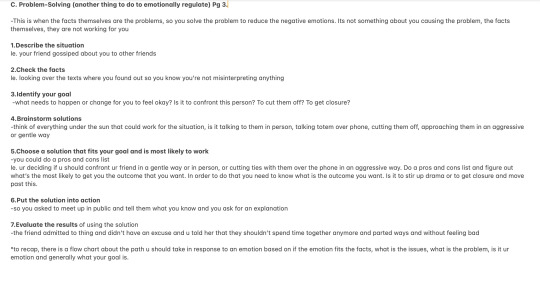


I transcribed her DBT series as it supports my learning but also because it comes in handy to have this written out in my notes app. Sharing in case anyone finds it beneficial <3 This is Module 3 of emotion regulation.
https://www.youtube.com/watch?v=MAQhlObvGOk
DBT has 4 modules 1. Mindfulness 2. Interpersonal Effectiveness 3. Emotion Regulation 4. Distress Tolerance Ana basically summarizes the exercises she perceives as the most useful and beneficial. I trust that she did a good job selecting which ones to add to her DBT series.
1 note
·
View note
Text
so murderbot assumes that three offered its armor because it doesn't understand that the armor can belong to it and thinks mb taking the armor is just good resource allocation.
but if it assumes it doesnt have control over the armor, it would probably let whoever it sees as in charge (maybe ART?) handle it, or at least make the suggestion directly to that person. even newly freed in NE, it's willing to give its security advice (on hostage situations being undesirable) even if it doesn't expect to be taken seriously. it doesn't make sense to me that it would have so much trouble expressing the offer if it were just a security suggestion.
and then i think about how murderbot says later in the book that even if three felt fondly toward its fellow SecUnits, the govmod would prevent it from expressing that care or knowing it was returned.
so-- imagine you're three, and you havent yet internalized that you can just say "i care about you and dont want you to get hurt" to another SecUnit; but you can make sure that it has every resource it might need; you could probably do that even before the govmod was hacked.
you can't explain why, but you can hope that the gesture is explanation enough, and you can look for similar caretaking gestures in return; things like being given code and advice to do your job better, and being reassured when you express that you're finding said job difficult.
i think *murderbot* isn't aware of this language of care, because it hasnt had much opportunity to bond with other constructs. but three probably is, and probably knows how to read between the lines and guess that murderbot is starting to care about it, too.
#system collapse#system collapse spoilers#murderbot spoilers#the murderbot diaries#secunit three#maybe this is obvious#but i just got really caught on that bit abt 3 not being able to know if its feelings were returned#bc on the one hand its a really heartbreaking example of how fucked up the governor module is#but it also feels like a bit too much of an absolute#if mb could write a hack of the govmod surely three + its fellows could do a few unnecessary but kind things for each other#its just that they could never *confirm*#still hellish but not the total isolation mb seems to imagine#murderbot diaries
1K notes
·
View notes
Text

shitty doodle of my ARAR Thymian and @schwarzgeier GEIR Kobalt (or at least its intended to be Kobalt, i hope i drew her right) before i head off to work
#i had a different idea in mind for this doodle#of a GEIR lifting Thymain like a child and telling her to speak#bcs she can't talk (damaged voice module)#but my brain isnt arting this morning apparently so this will have to do#i love these funky pyromaniacs so much <3#signalis#signalis oc#signalis fanart#signalis arar#signalis geir#basil did art
87 notes
·
View notes
Text
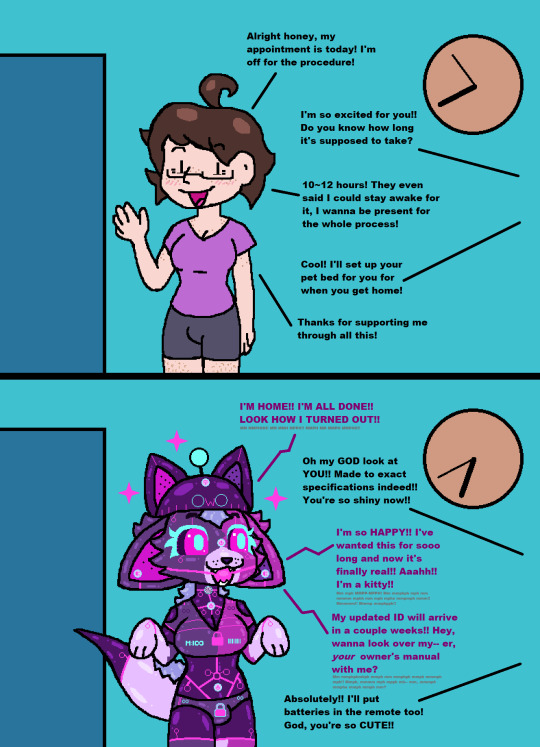
she got that conversion she always wanted!!
#my art#transformation#she’s gagged but can talk thru a voice modulator on her neck#so she’s mutable :3#myao
627 notes
·
View notes
Text
Dr. P Color Game - Module 3 part 2 #writ671mu

Today is blue! Blue skies, blue birds, and a blue police box:) at Who North America in Indiana.
2 notes
·
View notes
Note
Favourite fitzsimmons scene?
okay i know i just said i needed to think but then i thought of an answer immediately except it’s probably cheating because i can’t decide between three. all are pretty popular i feel but they’re just very important to me and obviously popular for a reason :)))
first thing i thought of was their first kiss in 3x08 because it’s just suuuuuuuch a scene that represents their overall dynamic with the yearning, the bickering, the jealousy….but it is also such a perfect culmination of everything leading up to it in the first parts of season three and also the other seasons and just very very iconic in my mind. i used to have the entire thing memorized word for word and now while i’ve probably forgotten some of it i’ve still got most of it in my brain
tying with that, i’d have to say two very very important scenes from season one. i know there are a lot of great scenes later on when their relationship is established and/or developing at a much more rapid pace but the foundations of their bond are just sooooo important to me. like the fzzt scene when they’re sitting on opposite sides of the glass quickly turning into an “argument” before fitz just says fuck it and goes in to help her regardless of the risk. amazing spectacular showstopping and we are only at episode six. also the containment module scene at the end of season one because come onnnnn the confession is everything and that scene and the events that directly follow it quite literally change both of their lives forever. also i just cannot with how baby they are, the way fitz says that she’s more than a friend to him and how she kisses all over his face and she’s sobbing it’s just too good lowkey
#asks#alethea <3#fitzsimmons#if i HAD to rank them……….honestly….containment module > first kiss > fzzt BUT idk i still feel like there are other scenes just as good#that i’m forgetting#or just smaller moment and stuff#but yeah :)))
22 notes
·
View notes
Text
Love your questions and Benson's piece makes me question too how many people are approaching mundane life situations as games? And how many life situations may we be somewhat unknowingly entering in a gameful mind? Especially in the context of Stenros's oscillating play theory -- will we ever truly be able when we are and aren't in a gameful mind as it can exist simultaneously?
Dr. P Check-in Gameful World Interstitial Questions
Can everything be approached with a gameful mind? Could doing that be destructive?
How much learning is lost or not done because his game was to get an A-, not actively learn? (I guess this really goes back to the destruction question)
@npfannen

3 notes
·
View notes
Note
sage i am patiently waiting for the android art fic dbh brainrot has struck me i fear… 😞
and i know i said that it was gonna be posted maybe this weekend, and then i said maybe monday, and then i went radio silent for like 36 hours, and yes i am a horrible tease for all of that and i apologize…..
im still working on it ! its marinating in my drafts while i think of how to properly end it. its not crazy long at the moment, it might end up being longer once its done, but i want to feel good about it before its posted. i owe it to my inner teenage girl who still dreams about connor
#dbh brainrot unfortunately does not go away#ever#connor is always at the back of my mind#anon i will be promptly locking in to finish it#i get it <3#tomorrow i finish my online training modules for my job so then i will be sooo much more free to write#sage’s asks
26 notes
·
View notes
Text




Lunar Module Test Article (LTA-3) during drop tests at Grumman Lab Facilities.
Date: February 1969
Posted on Flickr by Drew Granston: link, link, link, link
#Lunar Module#NASA#Apollo Program#Grumman Aerospace Corporation#Grumman#Factory#Bethpage#Long Island#New York#February#1969#LTA-3#my post
81 notes
·
View notes
Text
Love these connections! I also love how this situates the player at the center of play and the writer at the center of writing! Stenros really nails this down in some of his discussion as well with statements like "Playfulness is innate to the player” (203).
Also --Excellent gif choice-Wishbone is the GOAT!!!!!!!
Module #3: Original Content Writing
Connection to 1 play theory and the WPA Outcomes Statement. What can play add to our understanding of writing?
The one theory I go back to is Sutton-Smith’s belief that rhetoric of play is a form of identity. This is so important to me as a learner. I say this because just as the author stated “play tradition is seen as a means of confirming, maintaining, or advancing power and identity of the community of players” (305). Writers have an identity because their words belong to them. They are able to in their own way, “confirm, maintain, or advance the power and identity to the community of readers” because they are able to relate to their audience, make the reader comfortable, and identify.
On the flip side of that is self. This is the “idealized attention to the desirable experiences of the player(s) - their fun, their relaxation, their escape” (305). Let’s be honest. What English major doesn’t have a “fun” book? We all have one! 😄

3 notes
·
View notes
Note
Pharsalia came up in Latin class today and the professor sensed the class wasn't really convinced it was I quote "a magnificent work". So she tried to sell it by mentioning there's talking corpses and rains of blood in a very enthusiastic voice. And I thought of this blog.
it IS a magnificent work and it DOES have talking corpses and rains of blood! and also snakes that make you explode into goo and julius caesar's cannibal brunch! auhghghh i understand you professor in my heart because the pharsalia fucks and is sooo neglected by most classics courses which is terrible because, again, it fucks
#AND HAS SOOO MUCH TO SAY ABOUT SO MANY THINGS#evil and terrible and bad that we didnt get to study it in the MODULE ON EPIC POETRY???#so you hate historical epic? the genre that eats other genres? and talking corpses and rains of blood???#YOU want to read the pharsalia. and trap caesar's ghost in an evil time loop forever. pharsalia nostra vivet babeyyy#pharsalia#ok. very funny that you did think of me though. thank you anon <3#beeps
48 notes
·
View notes